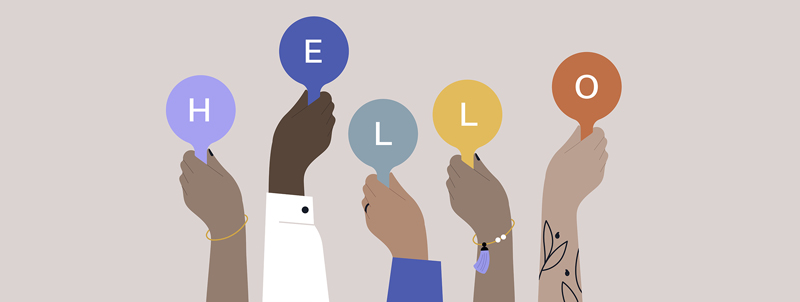
By Ayah Helmy
Every generation of Americans is tasked to wrestle with the reality of our racialized society. More than ever, conversations about race, gender, economic, and body privilege are being discussed in the news media, social media, and the halls of educational institutions. This means that we are tasked, more than any generation before us, to confront the realities of institutional racism, patriarchy, and economic injustice, among other things. This, of course, will not occur without intense disagreement and debate, but we owe these conversations to our contemporaries and our descendants.
As a lawyer of color and a professor of feminist legal theory and social justice theory, I spend a lot of time thinking about what it means to be a person with a racialized identity in this country. I am especially interested in the intersection of the law and these structures of racialization. This is why, in the past five years being a member of the Hennepin Lawyer committee, I have almost exclusively contributed articles about diversity, equity, and inclusion both within our profession and within the systems in which we operate as attorneys. And this is why I am writing this today.
Beginning this month, I will be contributing a regular column about diversity, equity, and inclusion.
"Issues we label as issues of diversity, equity, and inclusion are (1) in most decisions we make as lawyers every day, no matter what our practices are; and (2) fundamentally questions of justice, which we have all committed ourselves to by joining this profession."
I suppose the first question I must address is why I think it is important to discuss these issues. Here is why: because issues we label as issues of diversity, equity, and inclusion are (1) in most decisions we make as lawyers every day, no matter what our practices are; and (2) fundamentally questions of justice, which we have all committed ourselves to by joining this profession. So, these issues affect everyone—not just women, BIPOC, queer, poor, or disabled people.
Our great nation was built on the foundation of the concept of manifest destiny: the concept that white European colonists were destined by God to settle and expand their dominion across this continent. Inherently, the colonists saw this land as unoccupied—or at least unoccupied by those they deemed as people. The ensuing founding documents, legislation, common law, and culture that sprung forth from this philosophy are the basis of our society and legal system as we currently know it. Now we call manifest destiny by other names: spreading democracy across the globe, the American Dream, gentrification, capitalist enterprise; but it all stems from the same place.
The creation of our country, and therefore the institutions that uphold it, was inherently built on this racial hierarchy. Since then, we have tried to slowly dismantle the more explicit forms of this racial hierarchy. For example, slavery was abolished in the late 1800s and race-based disenfranchisement became illegal in the mid-1960s. However, with each of these attempts to dismantle race-based hierarchies, its vestiges endure, or forces remain at work to keep or strengthen the original racially discriminatory institution. So, for example, while slavery is known to have been abolished in the late 1800s, the same constitutional amendment that abolished it carved out an exception for prison labor. As a result, we have the largest prison population in the entire world, with over 2 million prisoners. We have more prisoners than China (1.7 million), a nation that has more than three times our population. While slavery was abolished, criminal codes and policing were expanded to maintain the enslaved labor force under the new rules, targeting communities of color. Currently, 38% of incarcerated individuals in federal prisons are Black, with Black Americans incarcerated at nearly five times the rate of white Americans. In Minnesota, the ratio is nine to one.
When it comes to voting, while it is illegal to stop a person from voting based explicitly on their race, voter ID laws, limitations in polling places and times, and gerrymandering of voting districts are some ways that we limit the ability of poor communities and communities of color to vote or the power of their voices.
In the courtroom, mandatory minimums, disparities in sentencing depending on the racializing of crimes, and other factors affect outcomes for different racial groups. Racialized jury selection, inherent biases of judges and lawyers, and distrust of the system as a result of these issues also contribute to different outcomes.
The reason why it is important to recognize, study, and understand these issues is not to cast aspersions on each other or make a person or group feel guilty. It is to challenge the norms as we have come to accept them and grow into the more perfect union that we have always aspired to be.
The reason why it is important to recognize, study, and understand these issues is not to cast aspersions on each other or make a person or group feel guilty. It is to challenge the norms as we have come to accept them and grow into the more perfect union that we have always aspired to be. I always remind my mentees and students, as well as myself, that we do not become the best versions of ourselves without failure, mistakes, self-examination, and multiple attempts at getting it right. The greatest athletes, musicians, thinkers, and leaders in the world do not become who they are because they are born that way, but through perseverance, trial and error, and learning from their mistakes. Our nation is one of the most impressive civilizations in modern history, and it has the potential to become greater by continually examining its flaws and working to create true equality, cohesion, and opportunity for all its citizens.
My column will delve into some of the obstacles that we are encountering in our pursuit of being the most perfect union; I hope it will provide fodder for conversation, critical engagement, and nuance.
 Ayah Helmy
Ayah Helmy
ahelmy@brighthealthplan.com
Ms. Helmy works as counsel for Bright Health and teaches at the Mitchell Hamline School of Law and the University of Minnesota. She formerly worked in private practice and as an assistant Ramsey County attorney, advising and litigating on behalf of county agencies.